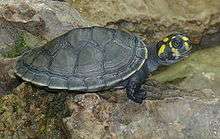Podocnemididae
Podocnemididae is a family of pleurodire turtles native to Madagascar and northern South America. Podocnemidid turtles are commonly called "side-necked turtles" in direct reference to their inability to retract their heads backwards, but hide them sideways. In addition, their pelvis[1] is fused to the shell which prevents any pelvic motion. Due to their pelvis being immobile they are unable to walk on land, which requires greater pelvis[2] mobility. For this reason, Podocnemididae turtles are best suited for swimming and as a result live in aquatic environments. These turtles are all aquatic[3], inhabiting streams and other flowing water. Their shells are streamlined to aid in swimming.
| Podocnemididae | |
|---|---|
 | |
| Yellow-spotted river turtle (Podocnemis unifilis) | |
| Scientific classification | |
| Kingdom: | Animalia |
| Phylum: | Chordata |
| Class: | Reptilia |
| Order: | Testudines |
| Suborder: | Pleurodira |
| Family: | Podocnemididae Cope, 1868 |
| Extant genera | |
|
and see text | |
| Synonyms | |
|
Podocnemidinae | |
Taxonomy and systematics
Podocnemididae has been merged into the closely related family Pelomedusidae as the subfamily Podocnemidinae. Some authors still maintain this classification,[4] but here it is preferred to keep them distinct families in the superfamily Pelomedusoidea instead.
The family Podocnemididae contains only three living genera, two of them monotypic:
- Erymnochelys – Madagascan big-headed turtle
- Peltocephalus – big-headed Amazon River turtle
- Podocnemis – South American side-necked river turtles
The family also contains a number of prehistoric genera, including Albertwoodemys, Bairdemys, Bauruemys, Brontochelys, Caninemys, Cordichelys, Dacquemys, Lapparentemys, Latentemys, Lemurchelys, Mogharemys, Neochelys, Papoulemys, Peiropemys, Pricemys, Shweboemys, Stereogenys, Turkanemys, Cambaremys, Carbonemys, Cerrejonemys, Kenyemys, Roxochelys and Stupendemys.[5] Stupendemys lived around 5.5 million years ago in northern South America, and was the largest freshwater turtle and the largest pleurodire known to date.
References
- Wise, Taylor B.; Stayton, C. Tristan (2017-03-01). "Side-necked Versus Hidden-necked: A Comparison of Shell Morphology Between Pleurodiran and Cryptodiran Turtles". Herpetologica. 73 (1): 18. doi:10.1655/HERPETOLOGICA-D-15-00038. ISSN 0018-0831.
- Sánchez-Villagra, Marcelo R.; Winkler, Jasmin D.; Wurst, Linda (2007-04-19). "Autopodial skeleton evolution in side-necked turtles (Pleurodira): Pleurodire autopodial evolution". Acta Zoologica. 88 (3): 199–209. doi:10.1111/j.1463-6395.2007.00267.x.
- Mayerl, Christopher J.; Brainerd, Elizabeth L.; Blob, Richard W. (2016-06-23). "Pelvic girdle mobility of cryptodire and pleurodire turtles during walking and swimming". The Journal of Experimental Biology. 219 (17): 2650–2658. doi:10.1242/jeb.141622. ISSN 0022-0949. PMID 27340204.
- Fritz Jürgen Obst (1998). "Pelomedusinae". In H. G. Cogger; R. G. Zweifel (eds.). Encyclopedia of Reptiles and Amphibians. San Diego: Academic Press. pp. 112–113. ISBN 0-12-178560-2.
- Eugene S. Gaffney; Peter A. Meylan; Roger C. Wood; Elwyn Simons; Diogenes De Almeida Campos (2011). "Evolution of the Side-Necked Turtles: The Family Podocnemididae". Bulletin of the American Museum of Natural History. 350: 1–237. doi:10.1206/350.1. hdl:2246/6110.
External links


- "Podocnemididae". Archived from the original on 2008-10-11. Retrieved 2008-01-22.